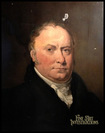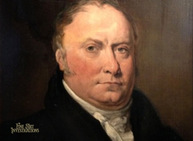Introduction
Fine Art Investigations evolved from the belief that art connects us to the truth better than the written word. Discovering history through art is the passion; identifying portrait artists is the by-product. A while ago, I had the opportunity not only to identify the artist of a portrait, but to learn a small historical fact that resonated deeply.
The Portrait

Oil on Canvas, 22 x 17 inches
Private Collection
Two thoughts came to mind when I first viewed the image. First, as the owner had suggested, the painting appeared to be English, not American. Secondly, the face seemed too far forward in the picture plane; the canvas may have been cut down.
The Clue
Usually research begins with provenance. In this case, though, the owner bought the portrait without provenance in 2011 at an antique fair in Portland, Oregon. The dealer, from Eugene, Oregon, had no information about the painting. Yet, pasted to the back of the relined canvas was a stupendous clue.

Search for the Artist – Problems
Name
In an extensive search of databases on both sides of the Atlantic, I could find no listing for a George Arrowsmith. The only artist with the surname Arrowsmith, who worked in the 19th century was Englishman Thomas Arrowsmith.
Occupation
Auction houses listed Thomas Arrowsmith as a painter of portrait miniatures.
Date
Biographies recorded Thomas Arrowsmith’s birth date as 1772 in London; his death date as 1830. If Arrowsmith died in 1830, he could not have painted William Joines’ portrait in 1831.
Search for the Artist – Solutions
These stumbling blocks, which could have been insurmountable, proved to be only pebbles.
Name
The portrait’s owner, a fine researcher in her own right, already had mentioned that the conservator could have mistaken a signature of “Tho.” for “Geo.” In the early 19th century, writers often flamboyantly scripted the first letter of a capitalized word, A “T” may have been mistaken for a “G,” especially if handwritten rather than typeset as in the examples below.

Occupation
As to the categorization of “painter of miniatures,” I knew that most artists painted whatever a paying customer desired, whether a miniature or a full-size portrait.
Date
A transcription or subtraction error was a likely explanation for a year’s discrepancy between artist’s death date and the date of the painting.
Addendum
Several years after this post was published, a blog reader contacted me with additional information. Thomas Arrowsmith was born in in 1772 in Newent, Gloucestershire (not London) and that he died in Oxford on July 28, 1839. As documentation, he attached a screenshot of the Gloustershire Journal dated August 17, 1839.

An unknown early biographer must have mistaken the “9” for “0.” Thomas Arrowsmith was alive in 1831 and capable of painting William Joine’s portrait.((Bill Milburn, email correspondence with author, June 19, 2017.))
Artist: Thomas Arrowsmith
A quick bit of research revealed that artist Thomas Arrowsmith lived and worked in London and Liverpool, but primarily Manchester, England. A William Joines was born around 1786 in Lancashire County, England. The city of Manchester straddles both Lancashire and Cheshire counties. In 1831, William Joines would have been about 45 years old, the approximate age of the sitter. The lives of the possible artist and subject intersected.
I left my Americanist comfort zone and traveled virtually to England to view works of Thomas Arrowsmith on the fabulous website, Art UK. Art UK had the proper death date for Arrowsmith. Although it is always heart-breaking to see paintings that have been allowed to deteriorate, the examples of Thomas Arrowsmith’s portraits clinched a probable attribution.
Resonance with this artwork continues. The portrait’s owner prepared a 25-page document on Thomas Arrowsmith that administrators of the Art UK site included in their archives.

Thomas Arrowsmith, Thomas Gabriel, ND 
Thomas Arrowsmith, Unknown Man, ND
Private Collection
Thomas Arrowsmith, Jockey Francis (Frank) Buckle, bef 1832
Private Collection
Thomas Arrowsmith William Joines , 1831
Oil on Canvas, 22 x 17 inchesPrivate Collection
Verifying First Impressions
The virtual viewing also verified the original first impression: that the painting was English. The second initial impression was that the canvas had been cut down. By converting canvas sizes from centimeters to inches, I found that Arrowsmith’s canvases were approximately 30 x 25 inches, the usual size of a head and shoulders 19th century portrait. Comparing the placement of the sitter in the Joines portrait with sitter placement in other Arrowsmith portraits, further indicated that the painting had indeed been cut down. Measuring 22 x 17 inches the portrait in America had lost nearly four inches on all sides. Paintings can be damaged over time. If unframed, it is not uncommon for the edges to fray. Then the canvas needs to be trimmed. But the size of these cuts seemed excessive.
A Poignant Discovery of History through Art
Shortly after attributing the painting to Thomas Arrowsmith, I ran into local gallery owner, Sue Raymond, in the produce department of a grocery in Ocean Park, Washington, on the Long Beach Peninsula. The Peninsula’s natural beauty attracts creative people, which makes the area a nearly idyllic artistic environment. Raymond, as a founder of Bay Avenue Gallery and its adjacent teaching studio, further enhances the local quality of life. Although Sue works in contemporary pottery and I work with 19th century oil on canvas portraits, we always find something to chat about.
That day, over our grocery carts, I told her about the cut-down Arrowsmith portrait. She shared a story with me. An friend of hers grew up in Britain. “He was one of the children packed off to be safely away from the bombing during World War II,” she said. He and his siblings waited out the war with relatives in Jamaica. Her friend told Sue that before he and his siblings left England, their parents cut family heirloom paintings into pieces small enough to fit into suitcases or to be sewn into their clothes. “He still has a cherub that looks as though it from a fine Spanish painting.”
Was the portrait of William Joines one of those family heirlooms? We will never know, but the fact that in the midst of war, people cared so much about their artworks that they cut them to fit suitcases or to sew inside children’s clothing speaks to the inexpressible and invaluable connection of people to art.

